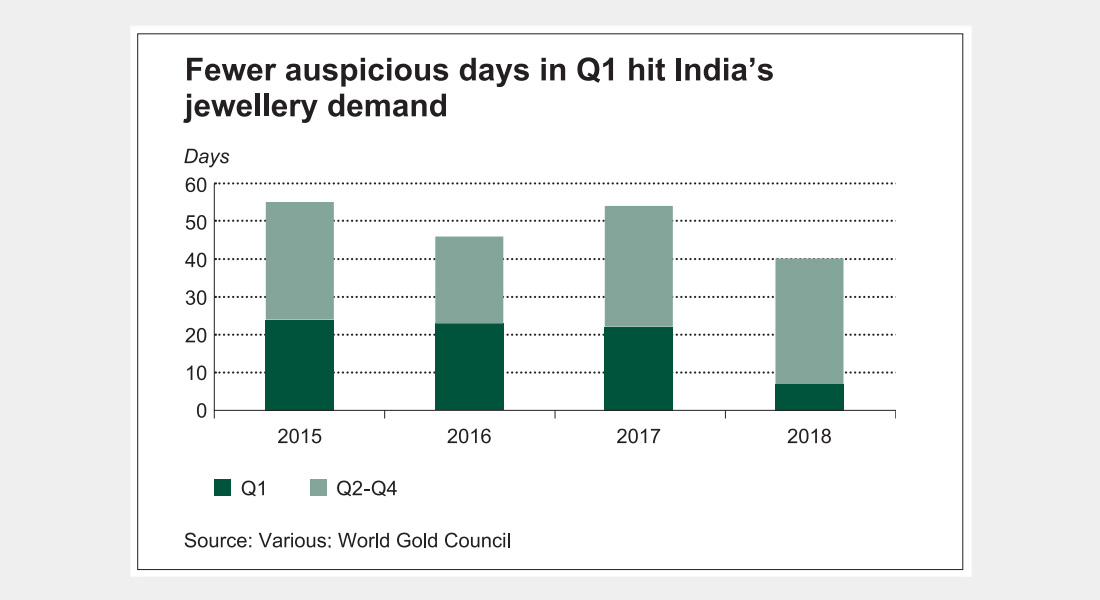After the strongest fourth quarter on record, Indian jewellery demand saw a sharp downturn in Q1, falling 12% year-on-year to 87.7 tonnes, the World Gold Council (WGC) stated in its latest Gold Demand Trends report. This was the third-weakest quarter in India’s jewellery market for ten years as a depreciating rupee magnified the rise in the international US$ gold price.
Despite the fact that the gold price was relatively stable compared with year-earlier levels, there was a perception of greater volatility among jewellery consumers, it noted. Some jewellery consumers responded by holding off from buying jewellery until gold prices stabilised.
Furthermore, the number of auspicious wedding days was far fewer: there were only seven auspicious days in the first quarter, compared with 22 in the same period of 2017. Given the importance of wedding-related demand to India’s jewellery market, this presented a major obstacle. The softness in the market was reflected by the local gold price, which traded at a small discount to the international price for much of the quarter.
Flows of gold into India were correspondingly light; stocks were depleted during the quarter. Official Q1 imports were down by around 50% year-on-year as retailers and fabricators reduced orders ahead of the Union Budget. The jewellery trade had built up healthy inventories during 2017 and, as imports shrank, these were used to meet a good portion of the demand.
Larger, national and regional chain stores reported better sales than smaller, single-store and medium retailers. This part of the market has acclimatised most quickly and easily to the introduction of GST. But the wider jewellery industry continues to make progress in adapting to the new GST regime. Market research suggests that GST compliance is relatively high. And field research indicates that almost three quarters of the gold currently being sold in India is accounted for properly.
The second quarter started well, with healthy demand during the April Akshaya Tritiya festival, despite higher local prices compared with last year. And looking ahead, improving macroeconomic indicators suggest a positive outlook for jewellery demand. Moreover, the Union Budget announced measures to boost rural incomes, including higher minimum support prices and an increase in agricultural credit. This bodes well for demand from the all-important rural sector, as does the forecast for a normal monsoon this year.
Global demand
The WGC said global gold jewellery demand was stable at 487.7 tonnes in the first quarter of 2018, just 3.9 tonnes or 1% below the first quarter of 2017. A combination of relatively stable gold prices and a broadly supportive economic environment sustained demand. However, the market remains weak when compared with longer-term historical average levels: five and ten-year quarterly average demand was 592.1 tonnes and 556.3 tonnes respectively.
Jewellery demand in China grew 7% in the first quarter to 187.8 tonnes – a three-year high. Demand was buoyed by jewellery themed around the Year of the Dog, which appealed to consumers buying during the Lunar New Year holiday. The start of the week-long holiday coincided with Valentine’s Day, which further boosted demand.
Demand for gold jewellery in the US grew 2% to 23.3 tonnes – the highest first quarter since 2009. Aided by supportive economic conditions, the market continued to build on the uptrend that started in 2013, highlighting the positive effect income growth has on gold jewellery demand. Online sales again showed strong growth, a trend that is expected to continue.
Turkey recorded the strongest growth of all markets in the first quarter: demand increased 19% year-on-year to 9.9 tonnes, despite a new record high in the local gold price.
Alistair Hewitt, head of market intelligence at the World Gold Council, said: “Relatively solid global economic growth, coupled with the return of volatility in the capital markets in February, created a stable environment for gold in Q1 – while equity markets around the world came under pressure, the gold price rose.
“Although demand was down year-onyear, we saw encouraging levels of jewellery demand in China, the US and Europe, continued growth in the technology sector, and steady inflows into ETFs, albeit at a slower pace than last year. Solid inflows into central bank reserves also highlight the ongoing relevance of gold as a strategic asset for institutional investors.”
The total supply of gold increased by 3% in the first quarter of 2018 to 1,064 tonnes, due to increased mine production and net hedging. Mine production and recycling levels both saw fractional increases compared with the first quarter of 2017, at 770 tonnes and 288 tonnes respectively.
China, Germany and the US drove weakness in bar and coin investment: global demand was down 15% to 254.9 tonnes. The range-bound gold price undermined investor interest in these markets, although China’s weakness was partly due to exceptional strength in the first quarter of 2017.


